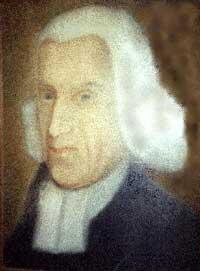Men of Great Learning in Bolton -or- The Mystery of the Missing Portrait
by Hans DePold, town historian
(Published in the Bolton Community News, August 2001)
Recently, I found a copy of the Hartford Courant from June 22, 1908. In it I discovered a small treasure of Bolton history: stories about the early Bolton ministers; and pictures of the missing portrait of Reverend George Colton, the original Bolton pewter communion set, and a wood carving of the Angel with Dove that adorned the original high pulpit.
The great institutions of American learning started as universities for turning out pastors: Both Harvard and Yale were originally schools of divinity. Yale provided the pastors for Connecticut and in 1723, when Bolton was large enough to afford a minister (17 active members), a young man named Jonathan Edwards came to Bolton and preached his first sermon. The congregation saw that the young man was well spoken and asked him to settle. The Hartford Courant reported that Jonathan replied, "I assure you that I have a great esteem of and affection to the people of your town, so far as I am acquainted with them, and should count it as a smile of Providence upon me if ever I should be settled among such a people as your society seems to present to me to be."
We have in our town records an entry dated November 11, 1723, in Jonathan Edwards's handwriting: "Upon the terms that are here recorded, I do consent to be the settled pastor of this town of Bolton. Jonathan Edwards." Jonathan Edwards never did settle in Bolton, instead sending his friend Thomas White to be our first pastor for 37 years. Edwards took a job at Yale and became Connecticut's most famous preacher.
Doing a little research on Jonathan Edwards, I found he was considered New England's finest mind during the period before the American Revolution known as the "Great Awakening." He spoke eloquently about what he called "the pursuit of happiness," an idea that became part of the Declaration of Independence. "Some, although they love their own happiness, do not place that happiness in their own confined good, or in that good which is limited to themselves but more in the common good..."
The second pastor in Bolton, the Reverend George Colton, served 49 years, including the period of the American Revolution. Reverend Colton, the "High Priest of Bolton," stood 6 feet 8 inches tall, had steel-blue eyes, and wore a large blue-white wig. According to the Hartford Courant, at one service a little girl saw Reverend Colton coming down the aisle wearing his wig and she shouted in excitement, "Oh, mother, here comes a man with a sheep on his head." His face was stern, and at least one man in town admitted that as a boy he would jump behind the nearest stone wall and hide when the minister swung down the roads of Bolton.
The famous American portrait painter Ralph Earl moved to Bolton supposedly to paint Reverend Colton but the minister would have none of such vanity. Although the Reverend was tall and stood in a high pulpit, children at the time said they could barely see him over the high-backed pews. It was by hiding his sketch paper behind a high pew that a congregation member managed to sketch Reverend Colton and then crudely paint his portrait when he got home. A copy was painted by Robert McKee in May 1879 and donated to the Bolton Congregational Church.

One of the greatest mysteries of Bolton is what happened to the original portrait. At the time of the article in the Hartford Courant in 1908, it hung in Memorial Hall on Asylum Street in Hartford. It is believed to have become the property of the Connecticut Historical Society, but its whereabouts have been unknown for as long as anyone in Bolton can remember.
Reverend Thomas White, artist Ralph Earl, and Reverend George Colton are buried in Bolton Center Cemetery.